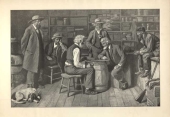The Checker Maven
The World's Most Widely Read Checkers and Draughts Publication
Bob Newell, Editor-in-Chief
Published each Saturday morning in Honolulu, Hawai`i
Contests in Progress:
One of Those Things

In our game of checkers, one of those things has, at least for us, brought to mind a couple of items, one of which is a problem with the terms shown below, Black to Play, White to Win, our latest entry in our ongoing Checker School series.
How are we supposed to know how Black is going to play when we're trying to win with White? Add to that, the diagram is shown on the Black side as our convention is to orient the board to the side which is on move.
However, there is a saving grace in that it's a very nice little problem, attributed to a noted Colorado problemist of bygone days, L. J. Vair. Yes, it's one of those, but it's worth the relatively minor annoyance.
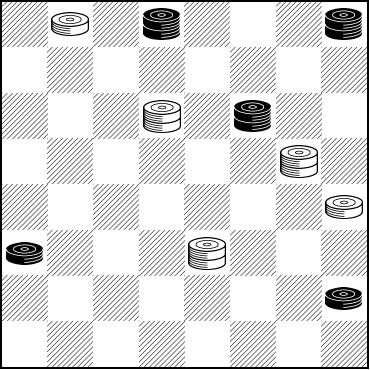
BLACK
Black to Play, White to Win
B:WK10,13,K17,K23,32:B5,12,K22,K29,K31
Don't yourself be one of those; solve the problem and then click on Read More to see the solution and notes.![]()
You Can't Win 'Em All
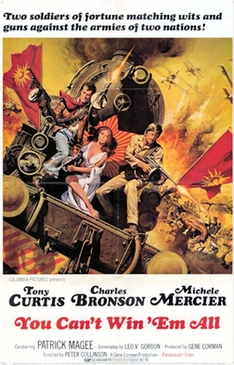
You can't win 'em all? No, you can't.
We've all heard the checker maxim "Keep the draw in sight." But we've also heard it said, "You have to take the chances to make the chances."
When we're a piece up, we expect to win. That's another bit of checker wisdom, and it's true--- except sometimes when it isn't. That practical maxim, "You can't win 'em all" might apply, as it does in the position below.
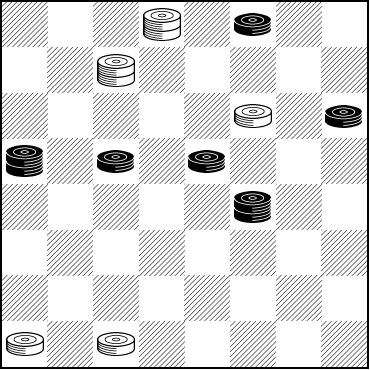
WHITE
White to Play and Draw
W:WK2,K6,11,29,30:B3,12,K13,14,15,K19
Black is a piece up but White can draw the game with the right play. It's really pretty easy and well within the reach of nearly all players. See how fast you solve it. Call it a personal win if you find the draw. After solving the problem a winning move would be to click on Read More to verify your solution.![]()
Beginner's Jinx

Pictured in the drawing above is a character named Jinx from The League of Legends, a multiplayer online battle game. No, we didn't know anything about the game or the character either, and with no disrespect intended towards players of the game, that might be just as well. On the fan site we are told this. "A manic and impulsive criminal ... Jinx lives to wreak havoc without care for the consequences."
We hope that there are few if any checker players who are manic and impulsive criminals, much less living to wreak havoc in any manner except across the checkerboard. And indeed today we're going to look at the more commonly known kind of jinx, something that brings bad luck. The following position, from Andrew Banks' quirky book Checker Board Strategy, is referred to by said Mr. Banks as "The Beginner's Jinx" and goes back to William Payne. It's this month's entry in our long running Checker School series.
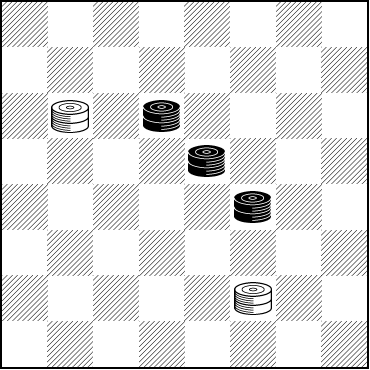
WHITE
White to Play, Black to Win
W:WK9,K27:BK10,K15,K19
Of course this classic 3x2 ending will present no difficulties for the experienced player, and is covered in many texts. Indeed you may wonder why we even bother to feature it. But we've presented such positions in the past because this ending can be baffling for newer players. The Checker Maven strives to provide a little something for everyone.
So don't jinx yourself. Novices and beginners, see how you do. Experienced players should solve it in seconds. Either way it's good practice, and clicking on Read More won't bring you bad luck but instead will show you one way to win it.![]()
Young Bill Salot at the Beacon Cafe: Contest #72
Editor's note: The following story serves as an introduction to Bill Salot's Problem Composing Championship, #72 in the series, which can be found on the contest page.
Winter had closed in on Bismarck, North Dakota. It was January, 1955 (it's always 1955 in these stories), and on a very cold and windy Saturday afternoon, the Coffee and Cake Checker Club had gathered for its weekly meeting.
At just after 1 PM, the usual starting time, several of the regulars were on-hand, occupying the big booth in the back of the Beacon Cafe in the Provident Life Building, the club's long-time regular venue. Wayne and Dan were there, along with Delmer, Louie the Flash, and Mike. Ron and Larry, who were less frequent attendees, had also come out, as Sal Westerman, the club's unofficial leader, had promised something special for this week.
In fact, Sal had just come through the front door of the cafe, along with a companion whom everyone instantly recogized from his frequently appearing photo in All Checkers Digest.
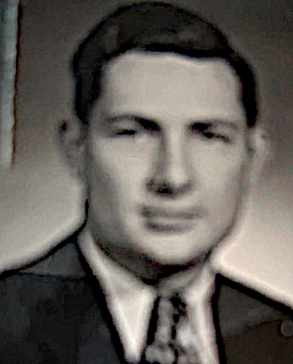
Young Bill Salot
The guest was none other than Young Bill Salot, who was only in his twenties but was already known to be a prolific problem composer, and the sponsor of the problem composing contests which ran every other month in the aforementioned All Checkers Digest.
The contests had been ongoing for quite some time. Young Bill would name a theme and solicit compositions from the best problemists in America, Canada, and beyond. Readers of the magazine would mail in their votes for their favorite problem, and the winning composer would receive a fabulous $100 prize.
Young Bill was on a nationwide lecture tour, discussing the art of problem composition at checker clubs throughout the land, and Sal had asked him to visit Bismarck--- in January, no less, even though Young Bill hailed from much warmer Virginia. Young Bill readily agreed to stop in and present a challenging problem and then give an informal talk about problem composition, even while expressing reservations about Bismarck's winter weather.
Everyone stood to greet Young Bill, who managed to shake hands with all of the "boys" (who were easily twice Young Bill's age), despite Young Bill's shivering and being red-faced from the zero degree outside temperature, not to mention the 20 mile-per-hour wind.

Deana Nagel
Deana, the proprietress of the cafe, came over from behind her counter to also offer Young Bill a cordial greeting. "Welcome to Bismarck," she said, "hope you like our weather!" She gave out a hearty laugh. "Sal tells me you're a fan of hot chocolate, would you like a cup to warm you up?"
Young Bill readily assented, and soon he was seated among the boys in one of the big booths.
After some preliminary chatter about Young Bill's lecture tour, and his highly regarded problem contests, Young Bill took the floor.
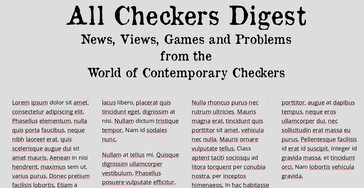
"The contest that was just published in All Checkers Digest, has a very special theme. It's called "Deferred Quadruples" and the name speaks for itself. Problems with this theme take a lot of skill to compose, and it's the kind of thing that doesn't come up very often over the board. But solving problems of this type are a great way to improve and train your tactical vision. A little later on, we'll get into some of the nitty-gritty detail, but for now I want you boys to try out a sample problem that isn't part of the contest but nicely illustrates the contest theme."
Young Bill set up the following position on a couple of the checkerboards which were on the booth's tables.
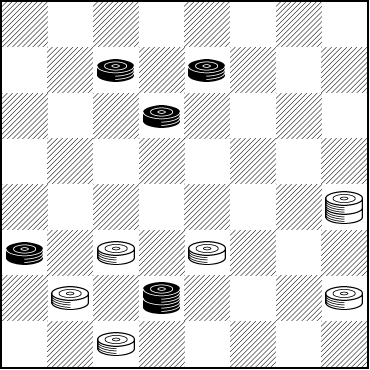
WHITE
White to Play and Win
W:WK20,22,23,25,28,30:B6,7,10,21,K26
"Now, I hear from Sal that you have a tradition about who buys the treats. If you solve the problem, Sal buys for everyone, but if you don't get it, you buy for Sal and his wife--- and for me, too, I hope!"

Everyone chuckled, and Deana, who never missed a trick, announced "I've got chocolate chip bars today!"
Young Bill smiled. "That's quite the incentive, so go to it, boys, and while you do, I'll warm up some more with another cup or two of Deana's great hot chocolate."
Deana hurried over and refilled everyone's coffee mugs and brought Young Bill his hot chocolate while the boys dug into the new checker problem.
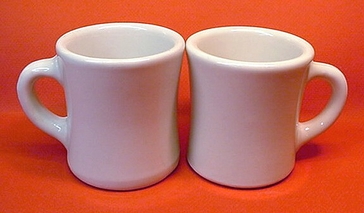
Sipping his hot chocolate, Young Bill said quietly to Sal, "You think they'll get it?"
"They're quite good," Sal replied, "and telling them the theme was a huge hint. So I think I'll be buying today."
It was Young Bill's turn to chuckle. "All the same to me," he said. "I'm looking forward to those chocolate chip bars no matter who buys. From what you've told me, I've got a real treat in store."
"How long will you give them to solve it?" Sal asked.
"We'll keep it to about 45 minutes so I have enough time to give my talk," Young Bill replied. "I sure want to get back to the Patterson Hotel before it gets much colder."
"My wife Sylvia and I will host you for dinner at the Patterson's restaurant," Sal said. "A shame you have to leave tomorrow morning. Where do you go from here?"

"Bozeman, Montana," Young Bill said. "I'll be speaking at the Montana State Checker Federation, and I'll get to meet up with that six-year old prodigy, Little Jimmy Loy, who already is making a name for himself. But it's probably just as cold there as it is here. Next time remind me to tour the northern states in the summer!"
You won't have to look for a January 1955 copy of All Checkers Digest to become a solver and a voter in the modern Bill Salot's 72nd contest in his ongoing series; all you need to do is click here to go to the contest page. Try out the three excellent problems found there and be sure to vote for your favorite. Unlike in our story, there are no prizes, but there is certainly plenty of great checker entertainment.
However, first try your luck against the boys and Young Bill with the sample problem above. When you're ready, click on Read More to see the solution and the conclusion of our little story.![]()
A Lot of Work

It's often said, and with good reason, that the road to success is paved with hard work. We've experienced this ourselves and we're sure many of our readers have as well. But the task above is seemingly impossible. It does pay to work smart as well as to work hard.
Now, although we're going to start off the New Year by working you quite hard, the task we're setting is achievable and we hope will prove to be worth your time and trouble.
Have a look at the following position.
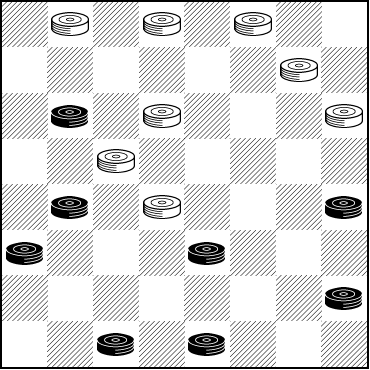
BLACK
Black to Play and Win
B:W15,19,21,23,25,30,31,32:B2,3,5,10,12,13,16,24
Certainly, Black has a small but visible advantage here; the question is, can you turn it into a win? You'll have to put some mental exertion into this one, but there is a way.
Work it out and then work your mouse over to Read More to see the solution.![]()
Happy New Year 2024

The New Year is just about upon us. What will you be doing for New Year's Eve?
Will you be out ballroom dancing?

Will you be on a New Year's Eve cruise?

Will you be celebrating at a big New Year's Eve party?

Or, will you be enjoying a quiet evening at home, perhaps solving a checker problem? This one is quite easy and we challenge you to find two solutions.
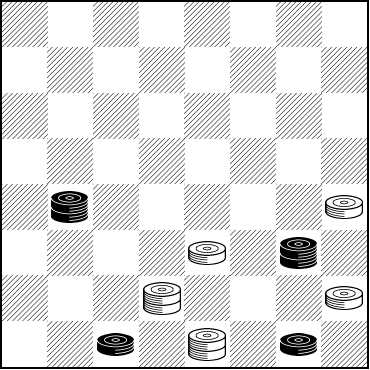
BLACK
Black to Play and Win
B:W13,10,5,K7,K2:B3,1,K16,K9
Whatever your choice, we hope you enjoy. For ourselves, as we've gotten older, New Year's Eve at parties or dances has become less appealing, and with the price of a cruise ... well, we'll probably just stay home. But that's just us. In any event, see how you do with today's checker problem and then click on Read More to see the solution.![]()
Three Kings

The photo above is of the Three Kings Monument in Chiang Mai, Thailand. It's a fitting header for today's Checker School column in which we present not just one but two problems involving three kings. Not ancient kings perhaps, but kings that figure prominently in instructive endgames.
The following pair of positions appeared in Andrew Banks' eclectic book Checker Board Strategy, which has been the basis of many recent Checker School columns.
The first one is really easy and is sort of a speedy warm-up. It's an illustration of finding a way to draw when a piece down. (Mr. Banks points out, however, that this position couldn't have arisen had not White blundered into it. Well, as they say, anything can and does happen in over the board play.)
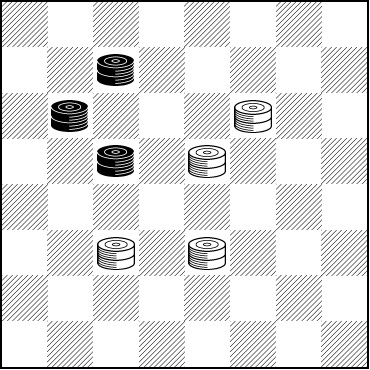
BLACK
Black to Play and Draw
B:WK10,K11,K18,K22:BK19,K24,K27
The second one will be easy for the experts and good practice for the improving player. Winning three kings against two baffles many a novice, and even a surprising number of players above the novice level.

WHITE
White to Play and Win
W:WK5,K13,K17:BK1,K6
Give these problems a royal effort, and after you've put on the crowning touches, click on Read More to verify your solutions.![]()
The Checker Maven: 19th Anniversary

This week The Checker Maven celebrates its 19th publication anniversary, and as we've said every year for some little while, we never expected to get this far, and we wouldn't have without our many loyal readers. We have no timetable and no prediction for how long our column will continue. It depends a lot on your aging editor's health and eyesight, neither of which are the best. All we can do is repeat that we'll go on as long as we reasonably can.
This anniversary we turn to someone whom we see as something of a role model, Bill Salot, who at above 90 years of age is still as active and productive as many who are many decades younger. We present one of Bill's best problems, about which noted problemist Brian Hinkle had the following to say.
"Roy Little and I decided to solve Bill's masterpiece The Clincher together by discussing it over the phone. We worked on it together, off and on, for about two months. I finally came up with the winning theme and shared my solution with Roy and he quickly agreed that I was correct."
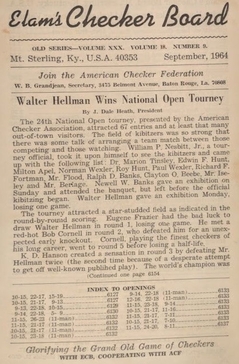
This problem first appeared in Elam's Checker Board, April 1962, Page 5260, Scorpion Club Column, where it was called Traveling Man.
Tom Wiswell included it in his The Science of Checkers and Draughts, 1973, Page 46, where he renamed it The Clincher.
Mr. Salot notes, and Mr. Hinkle confirms, "Brian Hinkle took days to solve it."
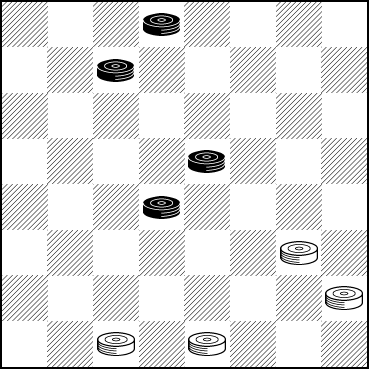
WHITE
White to Play and Win
W:W24,28,30,31:B2,6,15,18
Obviously this one isn't easy, but please join us in celebrating our anniversary by trying this one out. We're sure you'll like it, and you can always click on Read More to see the solution.![]()
Thanksgiving Weekend 2023

This column will appear on Saturday of Thanksgiving weekend, 2023. We hope you've had a wonderful Thanksgiving. Perhaps you were off on Friday and are enjoying a four-day weekend. Maybe you participated in the crazy shopping day known as "Black Friday" when, it is said, the ledger sheets of merchants turn from loss (red) into profit (black).
However, and even if you are celebrating, it's a weekend that can always use a good checker problem and maybe you have a little extra leisure time to take one on. We often turn to Tom Wiswell for a holiday problem, so here's a position we think you'll really enjoy.

BLACK
Black to Play and Win
B:W13,16,17,21,23,25,27,31,32:B1,3,6,9,10,14,15,18,20
Mr. Wiswell calls this one "The Gold Brick" and informs us as to its origin.
" ... White has just played 19-16 which allows Black a fine win. XXXX would have drawn, but many experts have walked into this inviting trap ... which originated from some analysis by the author (Mr. Wiswell) and Monte Schleifer."
We've redacted the move that White should have played and leave that as an exercise for the reader.
Try to solve this one. Maybe coffee and slice of pumpkin pie can be your reward once you win it ... or even if you don't, since you can always see the solution by clicking on Read More.![]()
Problem Composing Contest 71: Pitches

Throwing pitches is a big part of the game of baseball. The heart of the sport is the battle between the pitcher and the batter, and a good pitcher (considering modern baseball contracts) is worth literally many times his or her weight in gold. (180 pounds of gold at the time of writing is valued at about US $5 million.)
Pitches are also a big part of the game of checkers. Pitching a piece, while on the surface a loss of material, can result in a winning situation some moves later--- if it's a good pitch and doesn't let the opponent hit a home run and win the game.
Contest 71, in Bill Salot's superb long running series of checker problem composition contests, involves pitches. The four contest problems can be found here. Be sure to check them out and vote for the one you like best.
As an introduction to the theme, here's an example by noted player, writer, analyst, and problemist Jim Loy. It's an excellent problem which Jim created independently. Unfortunately it didn't qualify for the contest as it had previously been discovered and published with colors reversed by T. Riley, as Problem 513 in Horsfall's Problem Book, 1909.
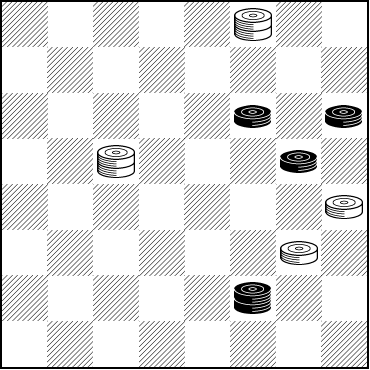
WHITE
White to Play and Win
W:WK3,K14,20,24:B11,12,16,K27
Will this problem throw you a curveball or be a sinker? We hope it's just a fastball that you can hit out of the park. Take a swing at it and then connect your mouse with Read More to see the solution. After that, go on to the contest page.![]()
The Checker Maven is produced at editorial offices in Honolulu, Hawai`i, as a completely non-commercial public service from which no profit is obtained or sought. Original material is Copyright © 2004-2025 Avi Gobbler Publishing. Other material is the property of the respective owners. Information presented on this site is offered as-is, at no cost, and bears no express or implied warranty as to accuracy or usability. You agree that you use such information entirely at your own risk. No liabilities of any kind under any legal theory whatsoever are accepted. The Checker Maven is dedicated to the memory of Mr. Bob Newell, Sr.

